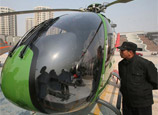
Back home, he uses a computer to modify the pictures into 3D images that can be used in the design.
It is a rare skill among his fellow craftsmen, but he has no intention of keeping it a business secret.
"Building statues is for the benefit of all Buddhists," Thubten Tsering says. "I don't do the job for the sake of business."
Migmar Losang's workshop is viewed by local craftsmen as one of the best in the village because of its good pay and accommodation.
Tenzin Kelzang, who is in his seventh-year of apprenticeship under Migmar Losang, admits that he is "not skilled, so I don't get a high salary."
"But I enjoy my job here. I want to inherit this unique craft," he says.
Thubten Tsering explains that "the most skilled worker earns 6,000 yuan ($965) a month and a new apprentice gets around 1,500 yuan".
"We help the youngsters save money, preventing them from wasting all their salary without handing it to their parents."
He says most orders come from U-Tsang in the central region of Tibet and Kham, which covers the eastern part of the autonomous region and western Sichuan province.
"No contracts are signed for orders as negotiations are done with lamas, who are considered supreme spiritual teachers by Tibetans, so trust plays the key role," Thubten Tsering says.
A recent commission was a 23-meter-high Buddha statue ordered by a lama from a monastery in Lhokha. The work took three years to complete.


















 Sea burial held in China's Tianjin before Qingming
Sea burial held in China's Tianjin before Qingming


![]()
